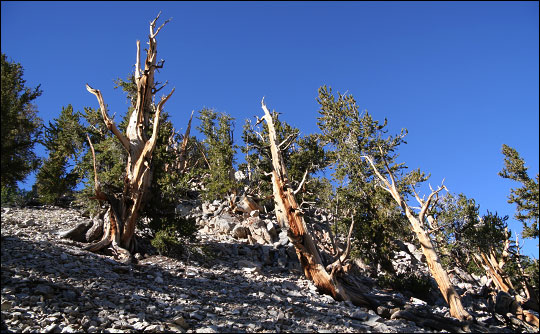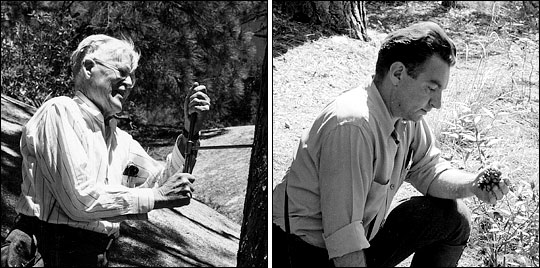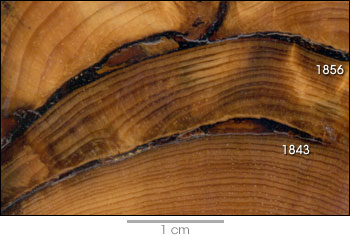

by Holli Riebeek· design by Robert Simmon· December 22, 2005 “This history in trees tells us the climatic story of the Southwest with amazing accuracy. When a real theory of climate has been developed and we can predict drought and flood over a period of years, this Arizona story in tree rings will have played a creditable part in developing that climatic foresight which is perhaps the most valuable economic advantage yet lying beyond our reach.” –Andrew Ellicott Douglass, 1929 While cave rocks and ice cores provide a long-term, annual record of past climate (see “Written in the Earth” and “The Ice Core Record” in this series), some other climate proxies can offer a detailed record of seasonal temperature or rainfall changes. As they grow from season to season, coral reefs in the oceans and trees on the land both record small variations in the climate. These records can tell scientists about growing conditions in the oceans or on the land, but the record only stretches across the collective lifetimes of the organisms that have been preserved through the centuries. Thus, even though their records are more detailed, reefs and trees cannot provide records that are as long or continuous as ice or sediment core records. |
| ||
 | |||
Tree RingsSquat and gnarled, Methuselah clings to the rocky slopes of the White Mountains in Southern California as it has for the past 4,770 years. When the ancient bristlecone pine took root, the earliest Greek civilization was being established and the Egyptians were just beginning construction of the Pyramids of Giza. Thousands of years later, both those civilizations are long gone, but Methuselah lives on. It is one of the Earth’s oldest known living organisms. The barren limestone soil around the tree is bare of grass or other plants, supporting only a widespread grove of scraggly Bristlecone Pine trees, at least one of which is even older than Methuselah. At about 11,000 feet above the arid Great Basin Desert, the trees receive precious little water—hardly a location hospitable to any life, let alone the oldest of living organisms. Ironically, it is the barrenness of the location that has allowed the trees to live so long. With no surrounding fuel, lightning-ignited forest fires can’t engulf the grove. |
The Methuselah Walk, high in the White Mountains of California, winds among the oldest known trees in the world. The ancient and twisted bristlecone pines grow extremely slowly, preserving a history of climate in their annual growth rings. The bristlecone climate record goes back 9,000 years, contained in living and dead wood as old as the last ice age. (Photograph copyright Dave Westwood) | ||
 | |||
The inhospitable environment has also made the trees excellent recorders of rainfall. Each year, the trees grow wider, adding another ring to their girth. Most people have counted the number of rings in a tree stump to find out how old the tree was, but the rings also tell about growing conditions the year it formed. High in the Great Basin Desert, where water is scarce, the growing conditions are most directly influenced by rainfall. |
Variation in the closely spaced rings of a bristlecone pine correspond to annual changes in rainfall and temperature. (Photograph copyright Henri D. Grissino-Mayer) | ||
 | |||
In the 1890s, a young astronomer at the Lowell Observatory in Flagstaff, Arizona, was trying to understand how sun spot cycles might affect plant growth. In his research, Andrew Ellicott Douglass noticed that the thickness of each ring in the pines and Douglas firs in the region depended on how much rain fell during the year. He wrote, “Through long-past ages and with unbroken regularity, trees have jotted down a record at the close of each fading year—a memorandum as to how they passed the time; whether enriched by added rainfall or injured by lightning and fire…. So, in the rings of the talkative pines we find lean years and fat years recorded. The same succession of drought and plenty appears throughout the forest.” Because all of the trees in the area exhibited the same pattern of thick and thin rings, Douglass was able to construct a tree calendar going back to AD 700 by piecing together the tree ring patterns of living trees and patterns found in wood preserved in Native American Pueblo villages. |
Andrew Ellicott Douglass (left) and Edmund Schulman (right) pioneered dendrochronology—the science of dating past events using tree rings. Douglass is shown coring a tree on the slopes of Mount Lemmon, above Tucson, Arizona. Schulman is pictured studying a pine cone in the same area. (Photographs by Charles Herbert, copyright University of Arizona Laboratory of Tree-Ring Research. | ||

In the 1950s one of Douglass’ former students and a respected tree researcher in his own right, Edmund Schulman, headed into the White Mountains to look at the trees rumored to be very old. He discovered Methuselah and the old bristlecone pines surrounding it. Around the trees, even older dead trees remained on the ground. Together, they gave a climate record of the Southwest United States that extends back 9,000 years, the longest record for a single tree species. In Europe scientists have combined the ring-records from various trees to piece together the past 11,000 years of Europe’s climate history. |
The first long-term record from tree rings was assembled from logs used in ancient Native American pueblos in the American Southwest. (Photograph copyright Scott August) | ||

Douglas’ rings tell about rainfall in the southwestern United States, but trees also respond to changes in sunlight, temperature, and wind, as well as non-climate factors like the amount of nutrients in the soil and disease. By observing how these factors combine to affect tree rings in a region today, scientists can guess how they worked in the past. For example, rainfall in the southwestern United States is the factor that affects tree growth most, but in places where water is plentiful, like the Pacific Northwest, the key factor affecting tree ring growth may be temperature. Once scientists know how these factors affect tree ring formation, scientists can drill a small core from several trees in an area (a process that does not harm the tree) and determine what the climate was in previous years. The trees may also record things like forest fires by bearing a scar in a ring. |
Short- and long-term variability of rainfall along the eastern margin of the Sierra Nevada is recorded in bristlecone tree rings. Several long and intense droughts that appear in the tree-rings are also found in sediments in nearby Mono Lake. (Graph derived from Hughes 1996) | ||

|
Individual events such as forest fires are recorded in tree-rings. The dark arcs that interrupt the sequence of rings in this sample were caused by fires in the 19th century. (Photograph copyright Henri D. Grissino-Mayer) |